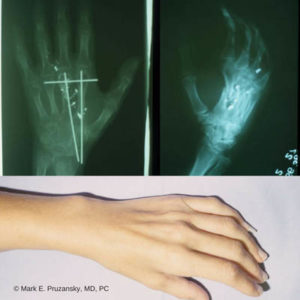Hand Surgery

Brachial plexus injury and palsy in the hand due to injury of the upper and middle trunks due to bullet wounds, open reduction internal fixation fractures of the second and third metacarpals due to bullet wound, operative pictures of brachial plexus nerve graft surgery for the bullet wounds.
What is Hand Surgery?
Depending on the underlying cause of the problem, there are many different types of hand surgery options.
The hand is incredibly complex and as a result many hand surgeons specialize in certain areas of the hand wrist, forearm and elbow. After your initial diagnosis, it is important to find a hand surgeon with experience in the care of your hand injury or condition.
Your hands play an important role in the way you care for yourself, help others and participate in activities. To do these things, your hand depends on a complex system of:
- Bones
- Articular Cartilage
- Joints
- Ligaments And Tendons
- Muscles
- Nerves
- Blood Vessels
- Bursae
An orthopedic hand surgeon with a specialty in hand surgery is trained specifically to care for problems that occur with these structures in both adults and children.
What Are the Different Types of Hand Surgery?
These are some of the common types of hand surgery:
Arthroscopy (AHR-THROS-KUH-PEE) is a medical term that simply means, “to look inside a joint”. Arthroscopic surgery is an example of Minimally Invasive Surgery, using a small surgical tool called an arthroscope that is equipped with a camera.
Microsurgery is the kind of hand surgery that is used to operate on very small structures such as the nerves and arteries of the hands and wrists.
Minimally Invasive Surgery includes arthroscopic surgery of the wrist, elbow, and shoulder, as well as some of the small joints of the hand.
Join replacement, or, arthroplasty, is an open surgical procedure in which a joint with irreparable damage or deterioration caused by arthritis or trauma is replaced with a man-made joint.
Traumatic injuries, especially lacerations, generally benefit from microsurgical repair. Direct repair of the injured nerve is the goal, but sometimes reconstructive techniques may be necessary, including nerve autografts, allografts, conduits, and transfers from neighboring healthy nerves, in order to optimize recovery of sensation and movement.
Tendon repair is an open surgical procedure in which the fibrous connective tissue that attaches muscles to bones is sutured together after lacerating or tearing injuries have compromised joint movement.
Sometimes a disorder or injury requires reoperation due to the complexity of the case or reinjury. Repeat reconstruction requires a hand surgeon specialist with special experience and expertise in all of the options, including the newest techniques available to maximize functional recovery.
Endoscopic Carpal Tunnel Release is an improved carpal tunnel surgery technique in which the hand surgeon accesses the wrist’s transverse carpal ligament via either a half inch or two quarter inch incisions (in distinction to the usual two-inch palmar cut that is standard in open procedures).
Mild discomfort at the base of your finger or thumb, where the joints meet your palm, may be the start of trigger finger. You may also notice increased sensitivity in this in area along with a small lump which is the inflamed tenosynovium.
How Long Does It Take to Recover from Hand Surgery?
Rapid Rehabilitation signifies maximizing recovery in the shortest safe period of time, utilizing the newest techniques to try and improve function, strength, coordination and sensation.
The concept and practice of Rapid Mobilization is applied to joints, tendons, muscles and ligaments to accelerate tissue remodeling, sharpen proprioception, and to reduce joint adhesions and athletic deconditioning.
Working with physical and occupational therapists, Dr. Pruzansky himself, directly supervises the exercise and splinting programs, progressing the patient in their rehabilitation by evaluating each person, individually. During these meetings each patient has their questions addressed, their progress noted, and their rehabilitation program updated. Sport-specific exercises are introduced at the appropriate stage in the patient’s recovery.
Here are instructions to follow after your hand surgery.
What Are the Alternatives to Hand Surgery?
Rest, ice, compression, splinting, bracing, corticosteriod injections, and physical and occupational therapy are common alternatives to hand surgery but depending on the extent of wear and tear, injury, or damage hand surgery may be the only option to try and improve the function use of your hand.
How Do You Know if You Need Hand Surgery?
During every consultation and surgical procedure we focus on the details. Outcomes of both surgical and nonsurgical treatments are measured and compared using internationally recognized metrics.
HandSport Surgery Institute is one of the country’s leading practices for minimally invasive surgery, providing patients with a quicker and less painful recuperation than with conventional surgeries.
We are dedicated to optimizing our patients’ lifestyles. HandSport® Surgery Institute is the Manhattan-based practice of Mark E. Pruzansky, MD, a pioneer in the field of Hand and Upper Extremity Surgery and Sports Injuries. As one of the country’s leading practitioners of Minimally Invasive Surgery, most patients have a quicker and less painful recuperation than with conventional surgery.
Named one of the Tri-State region’s finest hand surgeons in U.S. News & World Report magazine’s medical peer-reviewed “Best Doctors” issue, Dr. Pruzansky provides patients with innovative diagnostic and surgical care.
Conclusion
Mark E. Pruzansky, MD, is a pioneer of Hand and Upper Extremity Surgery. As one of the country’s leading practitioners of Minimally Invasive Surgery, most patients have a quicker and less painful recuperation than with conventional surgery. Call Dr.Pruzansky at 212-249-8700 to schedule an appointment, obtain an accurate diagnosis, and start to improve the function of your hand.



